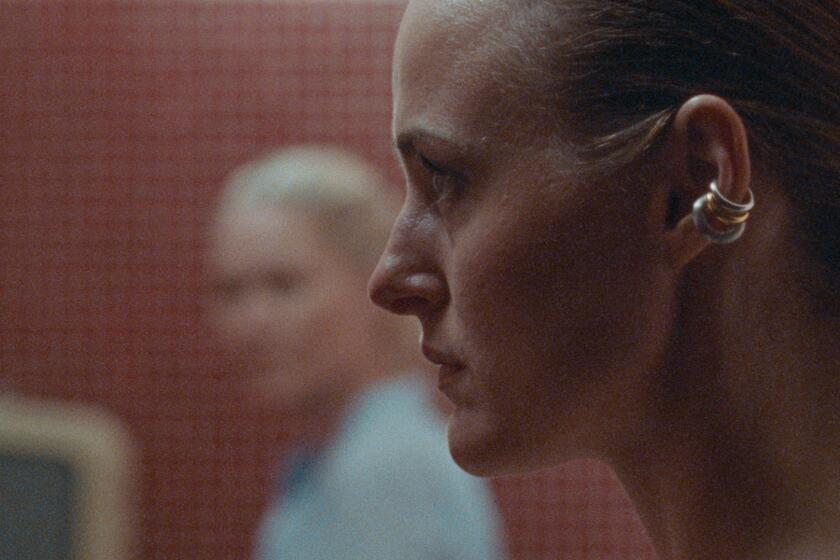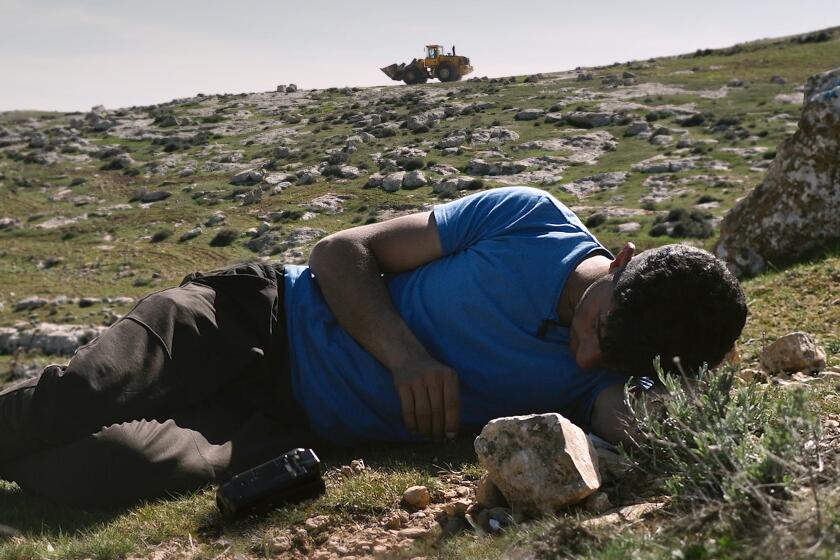THE OSCARS / ON FILM
- Share via
In looking at the Oscar category of best supporting actor and actress, I’m reminded of the sort of delicious dinner party that lingers in your memory years later. Although presumably you accept the invitation because you have some affection for the host, it is the unexpected alchemy of possibilities created by those on the guest list that heighten anticipation of the event.
Then the evening arrives. Though it might be subconscious or unfair, we tend to judge a party by the company it keeps with success resting on the narrow or broad shoulders of those around you. And so it is with supporting characters in movies.
They may come late and stay just a little while. Penelope Cruz doesn’t show up until nearly 40 minutes into “Vicky Christina Barcelona”; Michael Shannon was a late arrival in “Revolutionary Road,” as was Viola Davis with her single riveting scene in “Doubt,” and Josh Brolin in “Milk.” Or they might be there for the duration, spreading their energy across the evening: Philip Seymour Hoffman and Amy Adams in “Doubt,” Taraji P. Henson in “The Curious Case of Benjamin Button,” Marisa Tomei in “The Wrestler,” Heath Ledger in “The Dark Knight” and Robert Downey Jr. in “Tropic Thunder.” But it matters that they were there. In some fundamental way they season the experience. They each find a way to make the party unforgettable.
I’m not sure there is anyone around who can rage quite as compellingly as Cruz. She has a face that is stunning when it is quiet and contemplative, which it so rarely is. Eyes with pooling drops of sadness always, the not-quite-perfect nose and that wild tangle of hair. As Maria Elena in “Vicky Cristina Barcelona” the homicidal and suicidal ex-wife of Javier Bardem’s artist, Juan Antonio, she comes into the film bruised and angry. Once again, she is fearless, emotionally naked -- a body at war with itself, explosive, uncontained one moment, soft, repentant the next.
One scene. A tiny slice in the life of a film, that might well have landed on the cutting room floor but for the way it grabs you by the throat and refuses to let go. Such is Davis in “Doubt,” for me the most memorable of a rich season. You cannot breathe from the moment she comes into the frame as a mother learning that her child may have been molested by a priest. There is a lifetime of misery in every tentative glance, every nervous gesture. You can almost see the slender but fraying thread stretched between her hope and desperation, her fear and frustration. And when you finally do breathe, when she has disappeared behind a door, it is not relief you feel but wrenching sadness and desolation at the truth she has allowed you, forced you to see.
“Doubt” also brings us the twin pillars of Hoffman as Father Flynn, the fly under the microscope, and Adams, as the novice Sister James, whose vague concerns put him there. For both of them, it is an examination of loss -- Father Flynn’s arrogance will be stripped away, Sister James will lose nearly every shred of her innocence. The high-wire act that writer-director John Patrick Shanley has created is dangerous particularly for Hoffman, who must create an absolute balance between villain and victim so that we’re almost but never quite sure which he is. Hoffman’s body and his voice are his blessing -- with the slightest shift in either, he can change the temperature in the room. He can seem impossibly loose and tightly wound all at the same time.
Where Hoffman represents complex mystery, Adams comes in as simple clarity, transparency. Of all the characters in “Doubt,” Sister James is the one who could have most easily slipped into cliche. But Adams won’t let her -- moving step by careful step through the naivete, the righteousness, the confusion, the indecision and the disillusionment, handing each one to us to reckon with at just the right time and in just the right way. Sister James shrouded in black says volumes with the tentative dip of her head, the blush that stings her cheeks, her eyes at times piercingly direct, at others averted in shame. It is Sister James whom Shanley charges with leading us on this journey of uncertainty and ambiguity, and if there was a false note in Adams’ performance, the film would have been left to founder. She never does.
Sometimes roles are so utterly transforming that you will never be able to see that actor in the same way. For many reasons, that will be the case with Ledger’s Joker, locked in time as it will be by the 28-year-old actor’s death not long after the film finished shooting. It is easy for an actor to overplay an intentionally outsized character like the Joker, but Ledger never did anything the easy way. Instead, it was through excessive restraint that he found the cold, bloodless center of a psychotic killer’s heart. It’s as if Ledger replaced his own DNA with that of the Joker, so believable was the slump of his shoulders, the loping gait, the tightness in his jaw. Every snarled threat, every peal of crazed laugh, every malevolent sweep of his eyes is laced with just the right measure of caustic irony.
There is always an aching fragility in Tomei’s tough chicks, and it is there again in Cassidy, the damaged goods of a stripper afraid to love again in “The Wrestler.” Through Tomei’s sullen seduction of the losers who hover watching in the dark in the dump of a bar where she works, she offers up with remarkable veracity a life washed up and wrung out before its time. All of this Tomei manages to give us without asking for sympathy. Rejecting our pity, she instead infuses Cassidy with such dignity you are left torn between hoping that someone will save her and knowing that whatever saving there is will be at her own hand. You ache with her, but she won’t allow you to cry for her.
It’s difficult to watch someone unravel on-screen without a twinge of recognition; that thought, no matter how fleeting, that if you hadn’t found a way to step back from the edge of your own particular dark chasm, you might have become a version of Shannon’s electro-shocked and unhinged John Givings. Once Shannon charges into his scenes with Kate Winslet and Leonardo DiCaprio, the disintegrating couple at the heart of “Revolutionary Road,” a collective level of discomfort starts vibrating in the air around you; you can feel it intensifying with each exchange. It’s as if Shannon sets loose the insanity, letting it course through Givings’ veins as he wields his intellect like a machete, hacking through the face-saving lies the couple tell themselves, on his way to the utter emotional devastation that comes to rest at his feet. That the slayer is as tragic as those left bleeding in his wake is a tribute to the extraordinary calibration of Shannon’s performance; he reminds us in Givings that there is perhaps no more lethal weapon than rage and insight, and for that searing portrayal, he remains my favorite among the nominated supporting actors.
Comedy doesn’t get you a ticket to the Oscars often; parody is lower still on the food chain. So it is a testament to the brilliance of Downey that he is coming to the show this year on the back of his blackface portrayal of Sgt. Osiris in “Tropic Thunder,” Ben Stiller’s comic parody of the making of a Vietnam war movie. When he says, “Man up, we’re trained actors here,” as he surveys a real enemy camp, a machine gun loaded with blanks in hand, it manages to resonate with the sort of humor that makes you want to stick around for the next act. His absurdist portrayal is a bit like watching a clown car in reverse -- first in is Downey, next is his “real” self -- the Oscar-winning Aussie actor who’s been cast in the movie within the movie, then in goes the crusty black sergeant the Aussie will play. Though it’s not his best work or even his most challenging, what emerges finally is an absolutely unbelievable character that Downey makes believable.
There is a line of thinking that a dull intellect is as dangerous as a loaded gun -- unless the two are colluding as they do inside the head of Brolin’s Dan White, the San Francisco supervisor who killed gay political groundbreaker Harvey Milk and Mayor George Moscone. In “Milk,” Brolin mainlines the former cop’s internal agitation, his inability to completely understand how and why the world around him is changing, to build White from the inside out. Though Brolin has mastered the art of constructing a ticking time bomb, I didn’t find it as potent here as in “No Country for Old Men.” Still, he infuses White with enough petulant menace and then visible irritation that the gun is, after all, his court of last resort, so even though history had already written the ending, you find yourself scanning the screen for someone who will stop the madness.
It is difficult to play both with, and against, type as Henson does with such gentle goodness in “The Curious Case of Benjamin Button.” As a young, black servant in a whites-only nursing home in the 1920s, Henson’s Queenie could have turned into a one-dimensional relic left over from another place and time. Instead, Henson infuses such life into Queenie that you believe from the moment she picks up the impossibly hoary infant that she may be shaped by the prejudice that surrounds her but she will not share in it nor succumb to it. It is a difficult state of grace to achieve, particularly in what for me was a flawed movie. Yet Henson turns in a strong performance, creating a character so full of humanity and humility that you leave the theater half wishing that you too had been left on her doorstep.
--
More to Read
Only good movies
Get the Indie Focus newsletter, Mark Olsen's weekly guide to the world of cinema.
You may occasionally receive promotional content from the Los Angeles Times.











